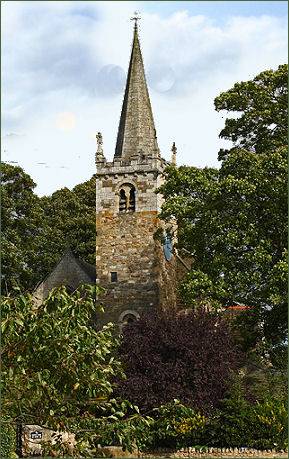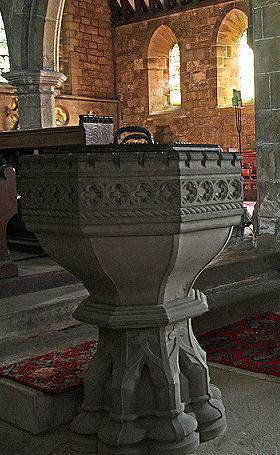Ledsham
OS grid reference:- SE 455 296

The pleasant West Yorkshire village of Ledsham lies 4 miles (6 km) to the north of Castleford and 11 miles (18 km) east of Leeds.
The village is first recorded around 1030 as Ledesham. Like nearby Ledston, the name seems to refer to Leeds, or the Old English precursor of this name, Loidis, which denoted a region rather than a town, meaning the ham 'homestead, farm' belonging to Leeds
 The village church All Saints (pictured left) is the oldest parish church in Yorkshire still in use. Built in around 670AD. it is not only the oldest church but also the oldest building in West Yorkshire.
The village church All Saints (pictured left) is the oldest parish church in Yorkshire still in use. Built in around 670AD. it is not only the oldest church but also the oldest building in West Yorkshire.
The walls of the nave and the base of the tower date to the early eighth century. The south door is decorated with carved stone motifs that may date back to the eighth century and were restored by Henry Curzon in 1871.
The tower was probably heightened in the later Anglo-Saxon period, but the belfry is a twelfth century addition. The chancel was rebuilt in the thirteenth century and in the fifteenth century the north aisle was added. The battlements were also added to the tower at this time.
Inside are seventeenth and eighteenth century monuments including those of Sir John (d. 1671) and Lady Sarah Lewis of Ledston Hall and against the north chancel wall is a monument to Lady Elizabeth (Betty) Hastings (1682-1739). Lady Betty was a woman much esteemed in her lifetime for her progressive piety and socially concerned benefaction, beside the church is the old girls boarding school which she founded.
The Chequers Inn (pictured below left) at the centre of the village dates back to the early 1600s and is one of the oldest traditional pubs in Yorkshire. Over the years very little has changed and many of the traditional Yorkshire pub features of low beams, alcove rooms and roaring fires are still in use. The Chequers Inn offers a selection of regional ales and a delicious daily food menu showcasing locally sourced produce. The pub serves traditional food with a mix of old and new favourites.
Situated in a north-south-running valley on the magnesian limestone, Ledsham Bank Nature Reserve supports vivid spikes of pyramidal, common spotted and fragrant orchids which are scattered around the site creating a stunning display in June and July.
Other typical limestone loving plants that flourish in the reserve include hoary plantain, yellow-wort, and impressive stands of the bright yellow dyer's greenweed - rare in Yorkshire. In summer field scabious and common knapweed give showy purple and pink flowers. A mature hedgerow runs down the west side of the nature reserve, providing food and shelter for winter finches and thrushes. A surprising number of butterflies have also been recorded here including small and large skippers, common and holly blues and commas.
Nearby Ledston Hall, a Grade I listed building, dates to the seventeenth century and was originally a grange and chapel built by the monks of Pontefract Priory, who were substantial land owners, some of their early thirteenth century chapel and kitchen still survives as part of the building. The hall has early formal gardens, pleasure grounds and a landscape park. The gardens and pleasure grounds cover some 7.5 hectares.
In the sixteenth century, Mary Pannell, a maid at the hall made a potion for the sick son of the house, she was later to be accused of witchcraft because the potion which was intended to be rubbed on the boys body was mistakenly given to the boy to drink by his Mother and proved fatal. Mary was sent to York on trial for witchcraft, where she was found guilty and brought back to the area where she was burned to death on a nearby hill which is still known today as Mary Pannell Hill.
Towns and Villages of Yorkshire
